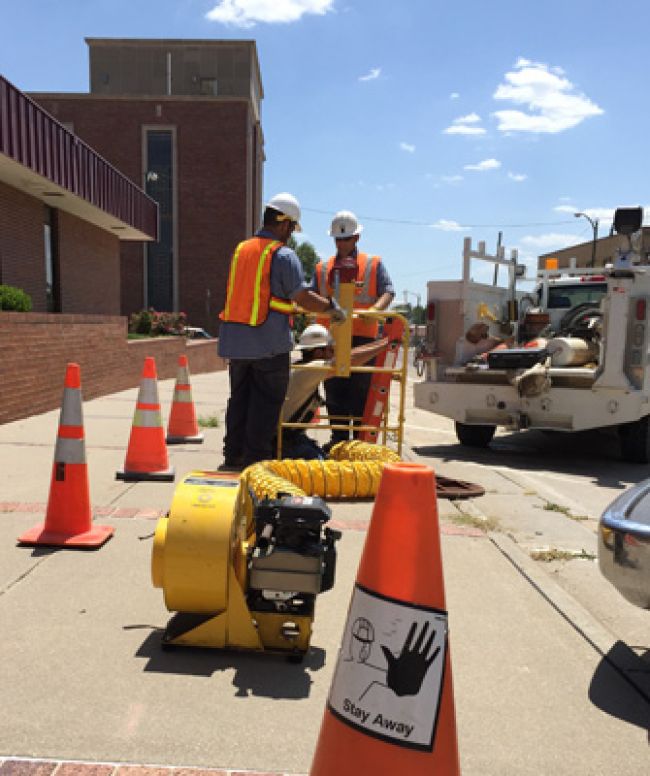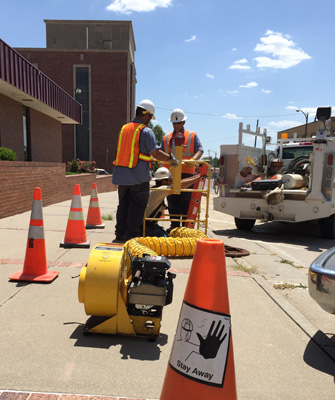
Safety Concerns When Working In and Around Manholes and Vaults

Some utilities – including electric, cable and communications providers – have had both underground and overhead applications for many years. However, more and more of these utilities now are either primarily installing their services underground or relocating overhead services underground, for a variety of reasons. These include reliability and protection from weather conditions, as well as minimizing exposure to equipment, vehicular traffic and farming operations. In addition to these safety concerns, utilities are installing services underground due to customer requests to improve the general appearance of the communities served by the utilities.
There are many beneficial reasons to install services underground, but there also are some downsides. Among them is the risk of personnel exposure to hazards when improper excavation practices are used. It is critical to adhere to OSHA 29 CFR 1926 Subpart P excavation practices as well as 811 and Dig Safe procedures. Another risk associated with underground facilities is that they often incorporate vaults or manholes that may be classified either as confined spaces or permit-required confined spaces. In either case, there are a number of safety concerns for which OSHA has implemented specific regulations that must be enforced to keep employees safe while working in these areas.
Safety should always be No. 1 on any job site. OSHA 1910.269(a)(2) states that all employees shall be trained in and familiar with the safety-related work practices, safety procedures and other safety requirements that pertain to their respective job duties. The agency goes on to say that employees who work in and around manholes must be trained on manhole rescue each year in order to demonstrate task proficiency. Proper documentation should be completed for the manhole training, as with any other training. The standard also states that the employee in charge shall conduct a job briefing or tailgate with all employees involved before the start of each job. At a minimum, the briefing should address the five areas required by the OSHA standard: hazards associated with the job, special precautions, energy-source controls, work procedures involved and personal protective equipment requirements.
Let’s take a closer look at some of the known hazards of working in and around vaults, manholes and other underground facilities, as well as what can be done to address those hazards.
Work Zone Protection
Work zone protection should always be considered and monitored throughout the duration of underground work in order to protect workers, motorists and pedestrians. The best way to provide this type of protection is to separate the work area from the non-work area. Clear signage regarding changes to normal traffic flow must be placed well in advance of the work zone so that motorists have sufficient time to react to those changes. Consideration also should be given to planning construction activities at times of the day when traffic may be reduced, in an effort to minimize exposure to both workers and traffic.
Work zone protection is the focus of the Manual on Uniform Traffic Control Devices, which specifically addresses worker protection as well as control of traffic flow through the use of signage, directional arrow boards, cones, barrels and barricades. Oftentimes a qualified flagman may be required to assist with traffic control. PPE is needed for those employees as described in the ANSI 107 standard on high-visibility apparel.
A number of utilities are now working with companies that specifically provide work zone protection; these partnerships often occur on road construction projects but are gaining in popularity in the utility sector. At Midwest Energy, the company I work for, we periodically utilize local law enforcement officials if additional traffic control is needed on a job site. In the past, these public officials have commented that they would rather assist with traffic control than be called to investigate an accident or a fatality. This partnership also has helped to foster stronger community relationships.
Atmospheric Testing
The integrity of a vault or manhole must be considered prior to entry. Precautions must be taken to verify that the structure is environmentally safe for entry by any employee, and it must be determined whether any permits are needed for facility entry. Pre-entry evaluation and testing should be accomplished by using test equipment that has been calibrated and is appropriate to detect any potential hazards that may exist or develop during the course of work. Testing should be performed by a qualified person who can recognize hazards and has the authority to stop work so that actions can be taken to ensure safe conditions. When work is being done in underground facilities, continuous monitoring of atmospheric conditions shall take place.
Testing should take place prior to removing the structure’s manhole or access cover. Rule 1910.146(c)(5)(ii)(A) previously required atmospheric testing before a cover was removed, but that has proven difficult for some cover designs. The standard recently was reworded and now requires that any conditions making it unsafe to remove an entrance cover shall be eliminated before the cover is removed. If it is possible to drop a gas detector through the cover, it should be done to ensure removing a cover does not create sparks that can ignite an explosive atmosphere.
Atmospheric conditions must be tested as indicated in Appendix B to OSHA 1910.146. This appendix specifies the procedures for evaluating the hazards of a structure or space as well as verifying that acceptable conditions exist for entry into the space. Appendix C to 1910.146 notes some of the most commonly known atmospheric conditions, identified as engulfment, the presence of toxic gases, the presence of explosive or flammable gases, and oxygen deficiency.
When testing the condition of underground facilities prior to entry, sampling should take place near the surface of the opening, midway into the enclosure and near the bottom of the enclosure. This is necessary due to the varying density levels of different toxic gases and vapors.
Atmospheric test results shall be captured and properly documented on approved forms. They must remain on the job site for the duration of the work and be retained for potential future use. OSHA provides sample permits and documentation forms in Appendix D to the 1910.146 standard.
Unsafe Conditions and Rescue Considerations
After entry has been allowed into the underground structure, and if during the course of work it is determined that conditions have become unsafe, the person performing atmospheric monitoring shall immediately instruct occupants to exit the enclosure until all conditions are once again made safe. Prior to any worker re-entry, new documentation should be created and include notes about the additional changes to the job site. If the facility has been documented as a permit-required confined space, a permit must be reissued. The entry form needs to capture pertinent information regarding the number of occupants so that all entrants are accounted for upon evacuation.
The underground structure’s location and design typically dictate any additional equipment needed at the job site. A retrieval device should be among the equipment to be considered during the job planning phase. This usually is a quad-pod or tripod device consisting of a ratcheting mechanism and retrieval line rated for personnel rescue, which attaches to the employee’s safety harness. In addition, there should be a designated person available to operate the retrieval device should an emergency situation arise. There also should be a designated employee continuously monitoring the atmospheric conditions of the space being occupied. If the space contains energized cable, there could be a possibility of an arc flash in the space. In that case, burning insulation creates immediately toxic fumes that disable entrants and change the classification from enclosed space to permit-required confined space. Rescue from such a space as required in 1910.146 is non-entry or properly trained rescuers entry with self-contained breathing systems. Planners should determine how best to meet that requirement in a worst-case scenario.
Being proactive before entry and monitoring conditions while work is occurring are industry best practices; engaging in these activities helps to assure that an unassisted evacuation of occupants will be possible if necessary, rather than a crew having to face an emergency rescue of individuals. If an employee becomes overcome by undesirable environmental conditions, all too often additional personnel succumb to the same conditions while attempting to perform a rescue. Employees should be trained and always remember to be part of the solution to the problem at hand.
Additional means of ingress and egress – such as a portable ladder or permanent rungs mounted to the side wall of the structure’s interior – also should be considered. Fresh air ventilation should be available to ensure that the proper level of oxygen is maintained in order to support life as well as prevent heat exhaustion and worker fatigue. Consider the use of a self-contained breathing apparatus if conditions warrant it.
Structural Inspections
Once a worker has gained access to the underground structure or space, an inspection of the surrounding area should take place. Look for any structural defects that can only be observable while inside the facility. Structural damage may have occurred due to changing weather conditions, nearby traffic or heavy loads. Other things to look for during inspections include low suspended pipe, cable trays and equipment, some of which may be pressurized or energized. While working in an underground space, it’s especially important to keep minimum approach distances in mind.
Other considerations include water and lighting. Water may have seeped into an area over time – perhaps from rain or overflowing storm sewers – and created hazardous working surfaces; note that slips, trips and falls remain one of OSHA’s most common recordable incidents. Certain types of lighting may act as ignition sources if there is a possibility of combustible gases being present in or migrating into the enclosure.
Summary
The specific practices, tools and equipment needed to safely and effectively work in underground facilities vary from location to location, but the items mentioned above provide a general overview of what is most common in the industry. Today there are a number of tool and equipment manufacturers that specialize in these applications and are willing to offer assistance so that worker safety is never compromised. The key to a successful workday is ensuring that every worker goes home at the end of their shift the same way they arrived – or even better.
About the Author: Michael Stremel, CUSP, has worked in the electrical industry for over 42 years. He spent 11 of those years as an industrial and commercial electrician, 21 years as a journeyman lineman and the past 10 years as the training manager at Midwest Energy, a cooperative in Western Kansas that serves electric and gas customers. Stremel currently serves as a member of four advisory boards for electrical vocational-technical schools in Kansas and is a member of the Midwest Energy Association. He also is an active member of the Joint Apprentice Training Committee and Joint Safety Advisory Committee at Midwest Energy.

